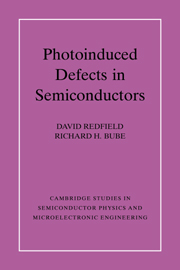Book contents
- Frontmatter
- Contents
- Preface
- 1 Introduction: Metastable Defects
- 2 III–V Compounds: DX and EL2 Centers
- 3 Other Crystalline Materials
- 4 Hydrogenated Amorphous Silicon: Properties of Defects
- 5 Hydrogenated Amorphous Silicon: Photoinduced Defect Kinetics and Processes
- 6 Other Amorphous Semiconductors
- 7 Photoinduced Defects in Devices
- References
- Index
6 - Other Amorphous Semiconductors
Published online by Cambridge University Press: 15 December 2009
- Frontmatter
- Contents
- Preface
- 1 Introduction: Metastable Defects
- 2 III–V Compounds: DX and EL2 Centers
- 3 Other Crystalline Materials
- 4 Hydrogenated Amorphous Silicon: Properties of Defects
- 5 Hydrogenated Amorphous Silicon: Photoinduced Defect Kinetics and Processes
- 6 Other Amorphous Semiconductors
- 7 Photoinduced Defects in Devices
- References
- Index
Summary
In this chapter we consider examples of photoinduced defect processes in a number of other amorphous semiconductors for comparison with the results previously described. These examples are drawn from research on amorphous AlGaAs, compensated amorphous silicon, amorphous germanium, alloys of amorphous silicon and germanium, amorphous silicon nitride, and finally the amorphous chalcogenides. General references for these subject areas are Disordered Semiconductors (Kastner, Thomas, and Ovshinsky 1987), the International Conference on Amorphous Semiconductors (1993), and the review paper “Photoinduced effects and metastability in amorphous semiconductors and insulators” (Shimakawa, Kolobov, and Elliott, in press).
DX Centers in Amorphous AlGaAs Films
A comparison of DX-center effects in crystalline and amorphous Si-doped A10.34Ga0.66As has been reported by Lin, Dissanayake, and Jiang (1993). Two questions are treated: How are the relaxation properties of the DX center affected by changes from crystalline to amorphous? What is the connection between the DX type of defect in crystalline and amorphous semiconductors?
Below 250 K, DX centers in amorphous AlGaAs exhibit persistent photoconductivity behavior, such as is characteristic of their behavior in crystalline materials. The decay of PPC can be described by a stretched exponential with decay time constant τ and decay exponent β, such that τ decreases with increasing temperature. A comparison of the temperature dependence of τ for amorphous and crystalline material is shown in Figure 6.1, and a similar comparison of the temperature dependence of β is shown in Figure 6.2. The values of r are larger for the crystalline than for the amorphous material, but the temperature dependence is approximately the same for both.
- Type
- Chapter
- Information
- Photo-induced Defects in Semiconductors , pp. 175 - 188Publisher: Cambridge University PressPrint publication year: 1996

